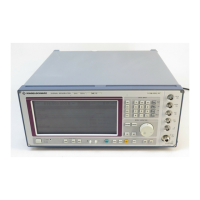Analog Modulations SME
1038.6002.02 2.60 E-13
2.6.2.5 Pulse Modulation
The pulse modulator can be controlled by an external source as well as by the internal pulse generator.
In the case of external control, the external source directly feeds the pulse modulator. The envelope of
the RF is identical to the control signal. In the case of control by the internal pulse generator, the pulse
form of the pulse generator determines the envelope of the RF. Pulse delay, pulse width and period can
be set.
The polarity of the pulse modulation is selectable. With POLARITY = NORM, the RF level is on with
HIGH level at modulation input PULSE. The input resistance is selectable between 50
Ω
and 10 k
Ω
.
2.6.2.5.1 Pulse Generator
As an internal modulation source, the pulse generator (option SM-B4) offers the possibility to set single
and double pulses with variable pulse delay, pulse width and period. The pulse generator can be
triggered internally or by means of an external signal at the PULSE input. The internal triggering is
derived from the reference frequency and hence very stable. In trigger mode EXT, the positive or the
negative edge can be used to trigger the pulse generator.
The pulse generator can also be operated as an independent function without the pulse modulator being
controlled if the pulse modulation source SOURCE is switched to OFF or EXT. The pulse can be tapped
at the VIDEO output.
The inputs and outputs to the pulse generator are at the rear of the instrument.
Signal examples:
SYNC signal
VIDEO signal
RF signal
PERIOD
WIDTH
PULSE DELAY
PULSE DELAY
WIDTH
Fig. 2-29 Signal example 1: single pulse, TRIGGER MODE = AUTO

